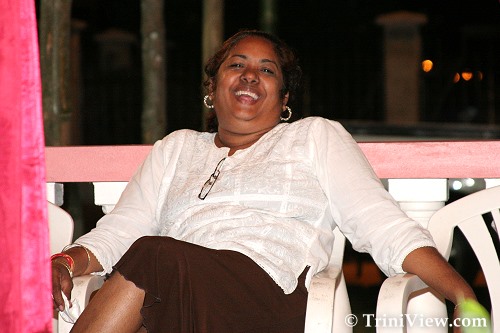 Indra relaxing as the celebrations wind down
Indra relaxing as the celebrations wind down
TriniView.com Staff Article
Event Date: December 15, 2006
The Maticoor night of the Hindu pre-wedding celebrations took place on Friday 15th December, 2006. Triniview.com did a brief interview with Indra Lillawtie Ramdhania, an aunt of the bride, to gather a bit of information about what takes place on the Maticoor night.
TRINIVIEW: Indra, what is the Maticoor night really all about?
INDRA: The Maticoor night is mainly about the women in the Dulahin's family preparing the Dulahin for marriage. The women are the ones who actually perform the ceremony and dance. There are three different phases that take place on a Maticoor night: the actual Maticoor ceremony which involves the dancing and digging of the dirt; the Saffron ritual with the doop grass; and the rubbing of the Saffron on the bride's skin, symbolic of the purification and beautification of the bride on the day of her wedding; and finally the application of Mehendi which is also another part of the bride's beautification.
TRINIVIEW: What is the significance of the Tassa drumming at the beginning of the Maticoor celebration?
INDRA: Basically, the Tassa drumming signals to everybody you are doing a celebration. The Tassa drumming is done at the beginning to bring in the celebrations.
TRINIVIEW: What is the name of the Tassa group and where are they from?
INDRA: They are the Raghu Boys Tassa Group from the village.
TRINIVIEW: There are men present here tonight. Is it a recent thing that men are allowed to be part of this ceremony?
INDRA: The men are not supposed to be here tonight because it's a ladies night. They came to see what is going on.
TRINIVIEW: Indra, could you share with us what happens after the Tassa drumming?
INDRA: After the Tassa drumming, the Maticoor ceremony begins with a ritual involving five elder married women and the youngest unmarried girl of the household. A ceremonial tray of hardie, sindur, deeya, lota and traditional sweets will be placed next to the bedi/baghie, an altar where the Pundit will perform the puja with the bride. The tray has to be lifted by the five elder married women and placed on the head of the youngest unmarried female girl. The girl will then lead a procession followed closely by close female relatives and friends and the five married women, one of whom carries a hoe to dig the earth and another one carries the flambeau/candle to the area where the actual Maticoor ceremony will be performed. After the ceremony is performed, they take back the dirt from the ceremonial site to where a Ground Wedding ceremony will be performed. A Ground Wedding is when everything is done in the ground. You also have what is called a Table Wedding which is when everything is done on the table.
After the actual Maticoor ceremony, the procession will return to the bride's home where the Pundit will take over. The bride would be in another area of the house and her mother would be asked to bring her out to join the Pundit at the bedi/baghie for the puja. Another phase of the Maticoor night is the Saffron/Saffran ritual. The bride will full her hands with rice and five little girls will take some doop grass and touch her toes, her knees and shoulders and then over her head five times. Finally the mehendi is applied with the assistance of friends and relatives, bringing the ceremonial part of the Maticoor night to an end.
TRINIVIEW: Thank you Indra.
Also Read:
Maticoor Night in pictures:
www.triniview.com/gallery/main.php?g2_itemId=153893
Homepage | Hindu Wedding | Photo Gallery
|
